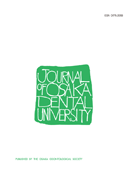Volume 43, Issue 2
Displaying 1-9 of 9 articles from this issue
- |<
- <
- 1
- >
- >|
-
Article type: Article
2009 Volume 43 Issue 2 Pages 129-134
Published: 2009
Released on J-STAGE: December 26, 2016
Download PDF (630K) -
Article type: Article
2009 Volume 43 Issue 2 Pages 135-141
Published: 2009
Released on J-STAGE: December 26, 2016
Download PDF (647K) -
Article type: Article
2009 Volume 43 Issue 2 Pages 143-147
Published: 2009
Released on J-STAGE: December 26, 2016
Download PDF (386K) -
Article type: Article
2009 Volume 43 Issue 2 Pages 149-156
Published: 2009
Released on J-STAGE: December 26, 2016
Download PDF (6436K) -
Article type: Article
2009 Volume 43 Issue 2 Pages 157-161
Published: 2009
Released on J-STAGE: December 26, 2016
Download PDF (407K) -
Article type: Article
2009 Volume 43 Issue 2 Pages 163-167
Published: 2009
Released on J-STAGE: December 26, 2016
Download PDF (677K) -
Article type: Article
2009 Volume 43 Issue 2 Pages 169-173
Published: 2009
Released on J-STAGE: December 26, 2016
Download PDF (500K) -
Article type: Article
2009 Volume 43 Issue 2 Pages 175-181
Published: 2009
Released on J-STAGE: December 26, 2016
Download PDF (684K) -
Article type: Article
2009 Volume 43 Issue 2 Pages 183-188
Published: 2009
Released on J-STAGE: December 26, 2016
Download PDF (454K)
- |<
- <
- 1
- >
- >|
